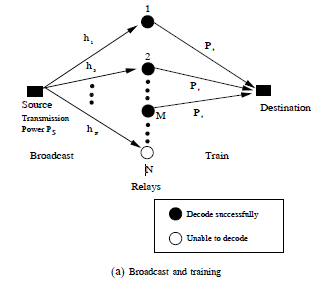TR2008-070
Energy-Efficient Cooperative Relaying Over Fading Channels with Simple Relay Selection
-
- , "Energy-Efficient Cooperative Relaying over Fading Channels with Simple Relay Selection", IEEE Transactions on Wireless Communications, Vol. 7, No. 8, pp. 3013-3025, August 2008.BibTeX TR2008-070 PDF
- @article{Madan2008aug,
- author = {Madan, R. and Mehta, N.B. and Molisch, A.F. and Zhang, J.},
- title = {{Energy-Efficient Cooperative Relaying over Fading Channels with Simple Relay Selection}},
- journal = {IEEE Transactions on Wireless Communications},
- year = 2008,
- volume = 7,
- number = 8,
- pages = {3013--3025},
- month = aug,
- issn = {1536-1276},
- url = {https://www.merl.com/publications/TR2008-070}
- }
- , "Energy-Efficient Cooperative Relaying over Fading Channels with Simple Relay Selection", IEEE Transactions on Wireless Communications, Vol. 7, No. 8, pp. 3013-3025, August 2008.
-
MERL Contact:
-
Research Area:

Abstract:
We consider a cooperative wireless network where a set of nodes cooperate to relay in parallel the information from a source to a destination using a decode-and-forward approach. The source broadcasts the data to the relays, some or all of which cooperatively beamform to forward the data to the destination. We generalize the standard approaches for cooperative communications in two key respects: (i)we explicitly model and factor in the cost of acquiring channel state information (CSI), and (ii)we consider more general selection rules for the relays and compute the optimal one among them. In particular, we consider simple relay selection and outage criteria that exploit the inherent diversity of relay networks and satisfy a mandated outage constraint. These criteria include as special cases serveral relay selection criteria proposed in the literature. We obtain expressions for the total energy consumption for general relay selection and outage criteria for the non-homogeneous case, in which different relay links have different mean channel power gains, and the homogeneous case, in which the relay links statistics are identical. We characterize the structure of the optimal transmission scheme. Numerical results show that the cost of training and feedback of CSI is significant. The optimal strategy is to use a varying subset (and number) or relay nodes to cooperatively beamform at any given time. Depending on the relative location of the relays, the source, and the destination, numerical computations show energy savings of about 16% when an optimal relay selection rule is used. We also study the impact of shadowing correlation on the energy consumption for a cooperative relay network.
Related News & Events
-
NEWS IEEE Transactions on Wireless Communications: publication by Jinyun Zhang and others Date: August 19, 2008
Where: IEEE Transactions on Wireless Communications
MERL Contact: Jinyun Zhang
Research Area: CommunicationsBrief- The article "Energy-Efficient Cooperative Relaying over Fading Channels with Simple Relay Selection" by Madan, R., Mehta, N.B., Molisch, A.F. and Zhang, J. was published in IEEE Transactions on Wireless Communications.
